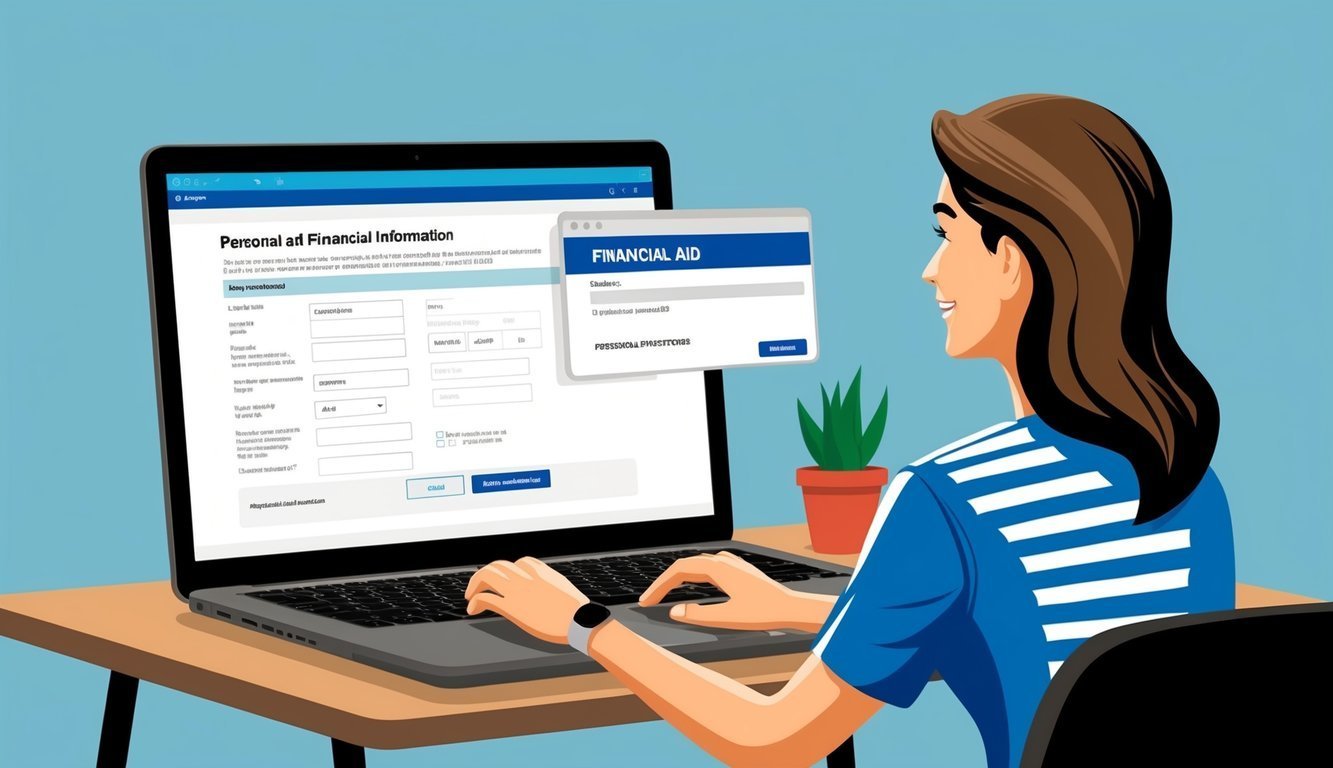Getting money for college can feel like trying to find the last cookie in a jar—that elusive but oh-so-desirable prize.
Don’t sweat it though; financial aid is here to lend a helping hand.
Trust me, tons of students rely on it to tackle tuition.

If you’re ready to take the plunge for financial aid, the first step is filling out the FAFSA.
It’s a form that helps the government figure out how much aid you’re eligible for.
Sounds a bit intimidating, huh? Don’t worry; it’s not as scary as it seems.
You’ll just need to provide some info about yourself and your family, plus details about your family’s income and taxes.
If you hit a snag, plenty of online guides and support centers are out there to help you out.
Just like figuring out how to sign up for medical assistance, getting familiar with the FAFSA can really boost your chances of landing financial support.
Don’t assume you won’t qualify for aid either—many folks think that way, but that’s often not the case.
It’s always worth a shot! You might just be amazed at how much help you can snag.
Don’t let procrastination win—dive into your FAFSA today!
Key Takeaways
- The FAFSA is your golden ticket to financial aid for college.
- Anyone can apply for aid, no matter where you come from.
- Submitting your FAFSA early can up your chances of scoring more aid.
Getting Ready to Apply for Financial Aid

Getting your ducks in a row for financial aid takes a bit of prep work.
You’ll want to gather necessary documents, understand the FAFSA inside and out, and check your eligibility.
Let’s break it down together.
Understanding the FAFSA
The Free Application for Federal Student Aid (FAFSA) is the key form for unlocking college funding.
If you want federal aid, this is your main go-to.
You’ll fill out the FAFSA online, and it asks about your family’s financial situation—think income, savings, and some other factors.
This nifty form opens doors to various types of aid: grants, loans, and work-study jobs.
Many colleges also use it to distribute their own funds.
It’s wise to submit your FAFSA early.
Some financial aid is given on a first-come, first-served basis.
The earlier you apply, the better your shot.
Gathering Required Documents
Alright, you’re ready to fill out the FAFSA, but first, let’s get those essential papers together.
Here’s your quick checklist:
- Your Social Security number
- A driver’s license (if you have one)
- Your tax returns
- Bank statements
- Records of any untaxed income
Oh, and if you’re “dependent,” you’ll need your parents’ info too.
It’s a bit of a team effort.
Creating an FSA ID is a great idea as well.
This unique username and password will make your life easier when dealing with federal student aid websites—both you and your parents should have one.
Having your documents organized will save you time and minimize mistakes, making the whole FAFSA process way smoother.
Determining Your Eligibility
Now, even though we’re all about inclusivity, not everyone gets federal student aid—there are some basic criteria.
Generally speaking, here’s what you need:
- Be a U.S. citizen or eligible non-citizen
- Have a high school diploma or GED
- Be enrolled in a qualified program
- Keep your grades up in college
Some types of aid come with extra rules—like Pell Grants, which are specifically for undergrads who haven’t snagged a bachelor’s degree yet.
Your financial eligibility largely depends on family income, but don’t assume you’re out of the running because of your salary! There are plenty of factors in play.
Just give it a go—applying might reveal some benefits you didn’t expect.
What’s the worst that could happen?
Filling Out and Submitting Your FAFSA
The Free Application for Federal Student Aid (FAFSA) is crucial for landing financial help when you’re heading to college.
It’s like opening the door to grants, loans, and work-study opportunities.
Let’s walk through what you need to do to complete your FAFSA successfully.
Creating an FSA ID
The first step is getting your FSA ID sorted.
This unique ID is how you’ll sign your FAFSA online.
Both you and your parents need your own FSA ID.
To create one, you’ll need:
- Your Social Security number
- Your full name (just as it appears on your Social Security card)
- Your date of birth
Keep that FSA ID handy! You’ll use it every year when applying for aid and to check the status of your help later on.
Filling Out the FAFSA Form
It’s time to tackle the FAFSA form itself.
Head over to StudentAid.gov to get started.
The form will ask about your family’s finances.
You’ll need:
- Your tax returns
- Bank statements
- Some info on investments
Take your time with each question.
Some may not apply to you, and that’s perfectly fine.
Just be honest and do your best.
Don’t forget about those deadlines! For the 2024-25 school year, the federal deadline is June 30, 2025.
But keep in mind that your state or school might have earlier cutoffs.
It’s smart to file as soon as you can.
Exploring Additional Financial Aid Options
The FAFSA is just the start of your financial aid journey.
You’ll want to look into other sources of funding, too.
Consider:
- Scholarships: Free money based on your achievements or talents
- Grants: Similar to scholarships, but often based on financial need
- Work-study: Jobs that can help pay for your education
- Private loans: They can fill in the gaps, but be cautious with these!
Some colleges require the CSS Profile, which is extra paperwork to unlock more aid at certain schools.
Reviewing and Understanding Your SAR
Once you submit your FAFSA, you’ll receive a Student Aid Report (SAR).
This handy document shows what you entered on your FAFSA and is worth a second glance for any errors.
The SAR will also list your Expected Family Contribution (EFC)—a magic number that helps schools determine how much aid you qualify for.
If you see any mistakes, correct them ASAP.
You can make FAFSA corrections online by logging in with your FSA ID and updating your info.
Keep your eyes peeled for the financial aid offers that will come from the schools you applied to.
These will outline what aid you can receive based on your FAFSA.
Frequently Asked Questions
Applying for financial aid can feel like a maze sometimes.
Here are some common questions students have when navigating the process.
What’s the process for applying for financial aid online?
It’s simple! Just fill out the Free Application for Federal Student Aid (FAFSA) online.
The FAFSA will ask you all about your and your parents’ finances.
After you submit, you may need to provide more documents to your school’s financial aid office.
Keep those lines of communication open!
When’s the best time to start my financial aid application?
Starting early is definitely the way to go.
Different schools and states have their unique deadlines.
You can submit your FAFSA as early as October 1 for the next school year.
The early bird gets the worm when it comes to financial aid!
What steps do I need to take to get approved for financial aid?
To get the ball rolling on financial aid, fill out the FAFSA each year and gather your tax and financial info before diving in.
Once you submit, keep an eye out for your Student Aid Report.
You might need to fix errors or provide additional info.
Should I apply to college before I fill out the FAFSA?
No need to apply to college first! You can list the schools you’re considering on your FAFSA.
It’s totally fine to submit the FAFSA before applying to schools.
You can always tweak your college list later.
How do I link my parent’s info when I’m doing the FAFSA?
Parents can use the IRS Data Retrieval Tool to pull their tax info into the FAFSA.
It speeds up the process and helps reduce mistakes!
If they can’t use the tool, they’ll need to enter info manually.
It helps to have your parents nearby while you fill this part out.
Got any tips for navigating the Student Aid government website?
The Student Aid website is packed with useful info! Use the search bar to quickly find answers.
Don’t hesitate to check out the chat feature for extra help, and the FAQ section is great for tackling common questions about financial aid.

